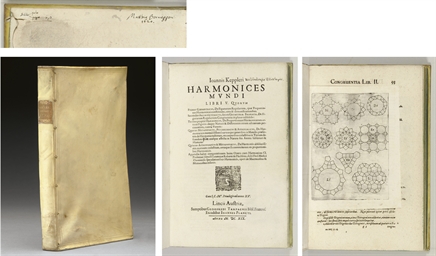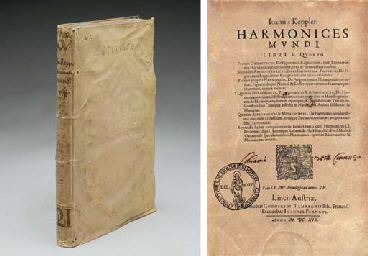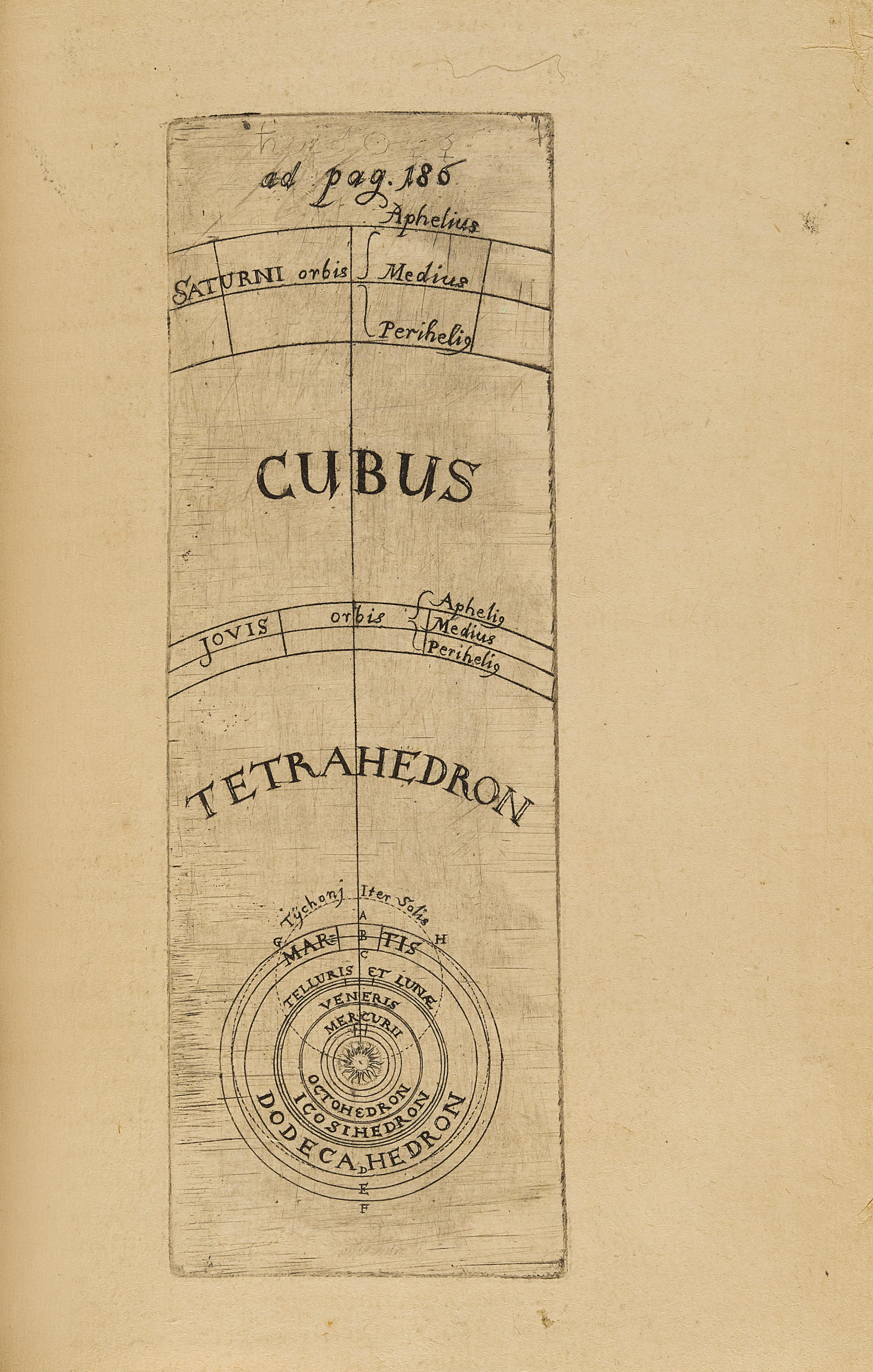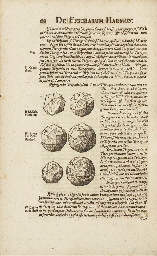KEPLER, Johannes (1571-1630). Harmonices mundi libri V . Linz: Johann Planck for Gottfried Tampach, 1619. [ Bound after :] – Pro suo opere Harmonices Mundi Apologia . Frankfurt: Erasmus Kempfer for Godefrid Tampach, 1621-1622. First edition of Kepler's great cosmological treatise , containing the third law of planetary motion. Kepler had drafted a plan for the work already in 1599, but he was unable to return to it until 1616. All of his previous work and the insights into the working of the cosmos that he had gained in the intervening decades served as material for this, his life’s work. ‘Certainly for Kepler this book was his mind’s favorite child’ (Caspar, Kepler, 1959, p. 290, quoted in DSB). An ardent Copernican, Kepler accepted that the sun was near the centre of the universe, but he went farther, by attributing physical force to it. Books I and II are concerned with the geometrical foundation of universal harmony, beginning with a detailed exposition of Euclid's Elements. He discusses polygons and polyhedrons and – for the first time – stellated dodecahedrons. Book III investigates harmonic proportions and music theory, while Book IV contains the fullest expression of his astrological views. In Book V Kepler refined the theory expounded in his Mysterium cosmographicum (1596), that the mean distances of the planets from the sun are in proportions related to spheres inscribing and circumscribing the five regular solids. ‘Now, imbued with a new respect for data, he could no longer dismiss [the earlier theory's] 5 percent error... In the astronomical book V... he came to grips with this central problem: By what secondary principles did God adjust the original archetypal model based on the regular solids?... In the course of this investigation, Kepler hit upon the relation now called his third or harmonic law’ (DSB). In this he related the magnitude of the planetary orbits to their periods of revolution around the sun, and established that the square of a planet's periodic time is proportional to the cube of its mean distance from the sun. Caspar 58 and 68; Zinner 4737; Dibner 6; Horblit 58; Norman 1207; Milestones of Science 115. See PMM 112. First edition of the Apologia . The appendix to Harmonices mundi contained severe objections to the rival theory expounded by Robert Fludd, the English physician and mystical philosopher, whom Kepler accused of ‘[taking] great delight in topics which are hidden in the darkness of riddles, whereas I strive to bring topics which are wrapped in obscurity out into the light of understanding’. Fludd rose to the challenge by publishing replies, which Kepler addressed in this Apologia by strenuously defending a cosmology founded on mathematics against a mystical approach. 2 parts in one volume, folio (295 x 189mm). Harmonices : first state of general title with printer's device and without text beginning 'Accessit nunc...', 5 section titles, with the dedication to King James of England *2r-*4r (later suppressed by Kepler and absent from a few copies), errata leaf at end; 5 engraved plates on 4 leaves, numerous woodcut diagrams and illustrations in text after W. Schickard, woodcut musical notation in Book III (title with stain resulting from a 19th-century round ink stamp on the verso, smudged, occasional foxing, printing fault on the errata). Apologia : large engraved vignette in title (title and last leaf a little browned, some light foxing). Early 19th-century boards, flat spine filleted in gilt with contrasting lettering-piece and small oval morocco stamp with monogram ‘v.Z’ (see below) at foot, sides covered with marbled paper (hinges and joints restored with new end-papers, corners and edges worn and rubbed, paper cover on spine worn off in places); modern custom-made box. Provenance: a few early short marginalia, cropped – ‘Zach’ (19th-century stamp on the first title and first divisional title of second work, and ‘v.Z’ gilt oval lettering-piece on the spine. This is one of the sta
KEPLER, Johannes (1571-1630). Harmonices mundi libri V . Linz: Johann Planck for Gottfried Tampach, 1619. [ Bound after :] – Pro suo opere Harmonices Mundi Apologia . Frankfurt: Erasmus Kempfer for Godefrid Tampach, 1621-1622. First edition of Kepler's great cosmological treatise , containing the third law of planetary motion. Kepler had drafted a plan for the work already in 1599, but he was unable to return to it until 1616. All of his previous work and the insights into the working of the cosmos that he had gained in the intervening decades served as material for this, his life’s work. ‘Certainly for Kepler this book was his mind’s favorite child’ (Caspar, Kepler, 1959, p. 290, quoted in DSB). An ardent Copernican, Kepler accepted that the sun was near the centre of the universe, but he went farther, by attributing physical force to it. Books I and II are concerned with the geometrical foundation of universal harmony, beginning with a detailed exposition of Euclid's Elements. He discusses polygons and polyhedrons and – for the first time – stellated dodecahedrons. Book III investigates harmonic proportions and music theory, while Book IV contains the fullest expression of his astrological views. In Book V Kepler refined the theory expounded in his Mysterium cosmographicum (1596), that the mean distances of the planets from the sun are in proportions related to spheres inscribing and circumscribing the five regular solids. ‘Now, imbued with a new respect for data, he could no longer dismiss [the earlier theory's] 5 percent error... In the astronomical book V... he came to grips with this central problem: By what secondary principles did God adjust the original archetypal model based on the regular solids?... In the course of this investigation, Kepler hit upon the relation now called his third or harmonic law’ (DSB). In this he related the magnitude of the planetary orbits to their periods of revolution around the sun, and established that the square of a planet's periodic time is proportional to the cube of its mean distance from the sun. Caspar 58 and 68; Zinner 4737; Dibner 6; Horblit 58; Norman 1207; Milestones of Science 115. See PMM 112. First edition of the Apologia . The appendix to Harmonices mundi contained severe objections to the rival theory expounded by Robert Fludd, the English physician and mystical philosopher, whom Kepler accused of ‘[taking] great delight in topics which are hidden in the darkness of riddles, whereas I strive to bring topics which are wrapped in obscurity out into the light of understanding’. Fludd rose to the challenge by publishing replies, which Kepler addressed in this Apologia by strenuously defending a cosmology founded on mathematics against a mystical approach. 2 parts in one volume, folio (295 x 189mm). Harmonices : first state of general title with printer's device and without text beginning 'Accessit nunc...', 5 section titles, with the dedication to King James of England *2r-*4r (later suppressed by Kepler and absent from a few copies), errata leaf at end; 5 engraved plates on 4 leaves, numerous woodcut diagrams and illustrations in text after W. Schickard, woodcut musical notation in Book III (title with stain resulting from a 19th-century round ink stamp on the verso, smudged, occasional foxing, printing fault on the errata). Apologia : large engraved vignette in title (title and last leaf a little browned, some light foxing). Early 19th-century boards, flat spine filleted in gilt with contrasting lettering-piece and small oval morocco stamp with monogram ‘v.Z’ (see below) at foot, sides covered with marbled paper (hinges and joints restored with new end-papers, corners and edges worn and rubbed, paper cover on spine worn off in places); modern custom-made box. Provenance: a few early short marginalia, cropped – ‘Zach’ (19th-century stamp on the first title and first divisional title of second work, and ‘v.Z’ gilt oval lettering-piece on the spine. This is one of the sta




.jpg)





.jpg)
.jpg)

.jpg)

Try LotSearch and its premium features for 7 days - without any costs!
Be notified automatically about new items in upcoming auctions.
Create an alert